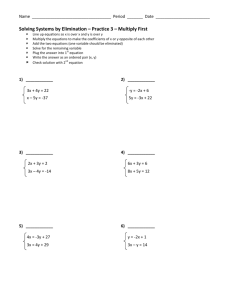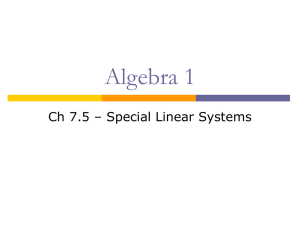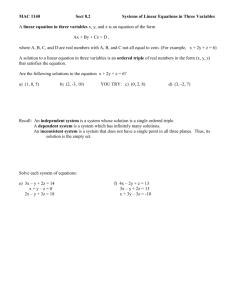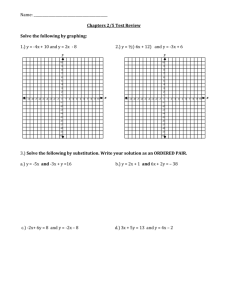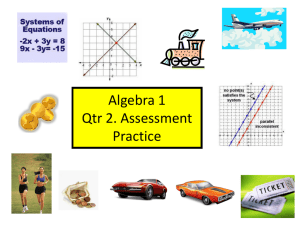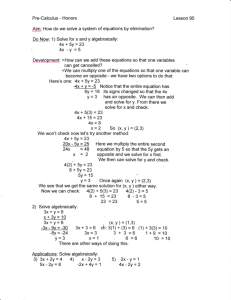Special Linear Systems
advertisement
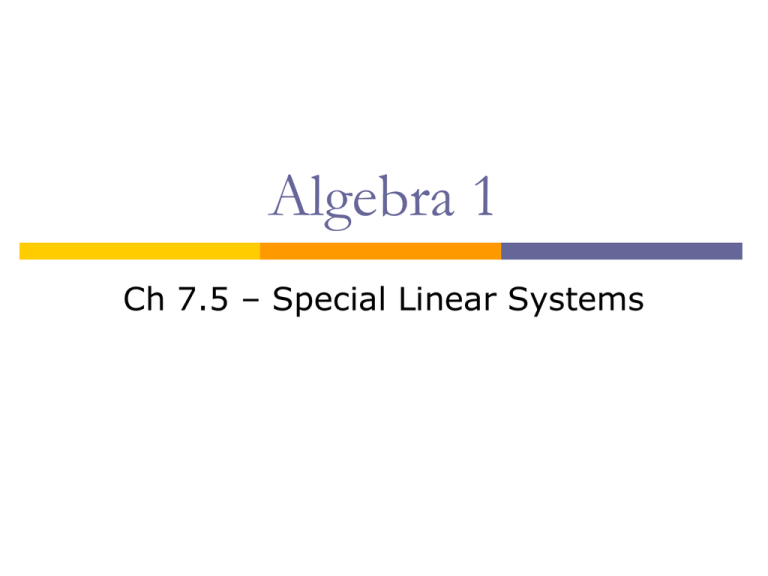
Algebra 1 Ch 7.5 – Special Linear Systems Objective I can identify linear systems with one solution, no solution or many solutions. I can model/show real-life problems using a linear system. Before we begin… In the last couple of lessons when we solved the liner systems of equations the result was one solution…that is not always the case… There are instances where the result can be no solution or many solutions… The goal of this lesson is to be able to solve the system of equations and interpret the results… Linear Systems – 1 Solution At this point you should be familiar with what a graph of a linear system with 1 solution looks like. Essentially, it is a graph where the lines intersect. The intersection point is the solution to the system of equations… Graphically, it looks something like this… y x Linear Systems – No Solution You can recognize the graph of a linear system with no solution because the lines do not intersect. In other words, the graph will be of parallel lines. No point on either line will be the solution to the linear system It looks something like this… y x Linear Systems – Many Solutions You can recognize the graph of a linear system with many solutions because the lines will be on top of each other. It means that all points on the line will be a solution to the linear system It looks something like this… y x Graphing vs. Algebraic Solutions When a linear system is graphed it is easy to interpret the results based upon what the graph looks like As you have already learned, graphing is not the only way to solve linear systems… It is equally easy to interpret the results when solving a linear system algebraically… When the variables are eliminated and you are left with a false statement, that means that the system has no solution (regardless of the values of x and y) When the variables are eliminated and you are left with a true statement, that means the system has many solutions (regardless of the values of x and y) Let’s look at some examples… Example #1 Using the substitution method we will solve the following linear system and interpret the results 2x + y = 5 Equation #1 2x + y = 1 Equation #2 Example #1 (Continued) 2x + y = 5 Equation #1 2x + y = 1 Equation #2 In this example I can solve either equation for y. I choose to solve equation #2 for y and then substitute the resulting expression into equation #1. Equation # 2 2x + y = 1 -2x -2x y = -2x + 1 Equation #1 2x + y = 5 2x + (-2x + 1) = 5 False 1=5 1≠5 In this example, the variable was eliminated and the resulting statement is false. Therefore, there is no solution to this system of linear equations. Something to think about… Mathematical Reasoning – The previous example uses proof by contradiction. That is you assume something is true, you show that the assumption leads to a contradiction or false statement, and conclude that the opposite of what you assumed is true. Example #2 Using linear combinations we will solve the linear system and then interpret the results. -2x + y = 3 -4x + 2y = 6 Equation #1 Equation #2 Example # 2 (Continued) -2x + y = 3 Equation #1 -4x + 2y = 6 Equation #2 After analyzing the equations, I choose to multiply equation #1 by -2. Then add the equations. Equation #1 -2x + y = 3 (-2) (-2x + y = 3 ) 4x - 2y = 6 Combination 4x - 2y = 6 -4x + 2y = 6 0=0 True In this example, the variables were eliminated and the resulting statement is true. Therefore, there are many solutions to this system of linear equations. Comments At this point it is expected that you can solve systems of linear equations using a variety of methods… It is not enough to be able to mechanically solve the linear systems…you are also expected to be able to interpret the results… Interpreting the results and/or applying the results to other situations are called higher order thinking skills… Yes…we want and expect you to be able to think at a higher order! Comments On the next couple of slides are some practice problems…The answers are on the last slide… Do the practice and then check your answers…If you do not get the same answer you must question what you did…go back and problem solve to find the error… If you cannot find the error bring your work to me and I will help… Your Turn Solve the linear systems (use any method). State the number of solutions. 1. 2x + y = 5 -6x + 2y = 4 2x + y = 7 -x + y = 7 -4x + y = -8 2. 3. 4. 5. and and and and and -6x – 3y = -15 -9x + 3y = 12 3x – y = -2 2x – 2y = -18 -12x + 3y = -24 Your Turn 6. -4x + y = -8 and 2x – 2y = -14 7. -7x + 7y = 7 and 2x – 2y = -18 8. 4x + 4y = -8 and 2x + 2y = -4 9. 2x + y = -4 and 4x – 2y = 8 10. 6x – 2y = 4 and -4x + 2y = -8/3 Your Turn Solutions 1. 2. 3. 4. 5. Many solutions No solutions 1 solution No solution Many solutions 1 solution (5, 12) 7. No solution 8. Many solutions 9. 1 solution (0, -4) 10. 1 solution (2/3, 0) 6.
